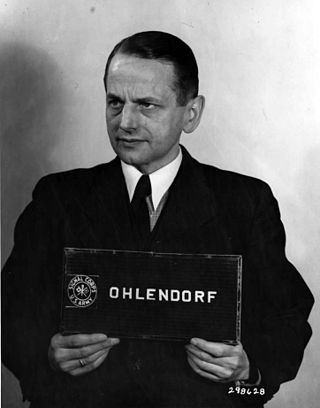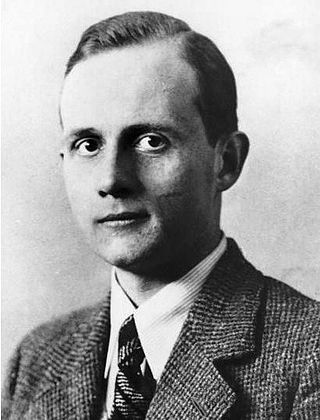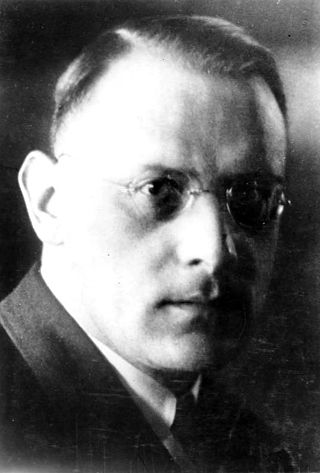Alan E. Steinweis (born 1957 in Brooklyn) is an American historian and a professor at the University of Vermont.
Alan E. Steinweis (born 1957 in Brooklyn) is an American historian and a professor at the University of Vermont.
Steinweis earned his doctorate in 1988 at the University of North Carolina at Chapel Hill under Gerhard L. Weinberg. As a PhD student Steinweis was a fellow at the University of Bonn and a postdoctoral fellow at the Free University of Berlin. He was a guest professor in 2000 at the Ben Gurion University in Israel, in 2002 at the University of Hannover and in 2003 at the University of Heidelberg. In 1993 he joined the University of Nebraska at Lincoln (Nebraska), as the Hyman Rosenberg Professor of Modern European History and Judaic Studies in the Department of History. [1] In 2011, he was invited for a sabbatical at the Fritz Bauer Institute in Frankfurt. In 2012, Steinweis was appointed Leonard and Carolyn Miller Distinguished Professor of Holocaust Studies at the University of Vermont, where he also serves as Director of Carolyn and Leonard Miller Center for Holocaust Studies. [2]
His book Studying the Jew was a Finalist for the National Jewish Book Award in the Holocaust category. [7] He is editor of the American edition of the Comprehensive History of the Holocaust, a monograph series published by the University of Nebraska Press in cooperation with Yad Vashem, the Holocaust research and commemoration authority of the state of Israel. He is currently writing a book on the November 1938 Kristallnacht pogrom in Germany, which will be published by Harvard University Press.

Kristallnacht (German pronunciation:[kʁɪsˈtalnaχt]lit. 'crystal night') or the Night of Broken Glass, also called the November pogrom(s) (German: Novemberpogrome, pronounced[noˈvɛm.bɐ.poˌɡʁoːmə] ), was a pogrom against Jews carried out by the Nazi Party's Sturmabteilung (SA) and Schutzstaffel (SS) paramilitary forces along with some participation from the Hitler Youth and German civilians throughout Nazi Germany on 9–10 November 1938. The German authorities looked on without intervening. The euphemistic name Kristallnacht comes from the shards of broken glass that littered the streets after the windows of Jewish-owned stores, buildings, and synagogues were smashed. The pretext for the attacks was the assassination of the German diplomat Ernst vom Rath by Herschel Grynszpan, a 17-year-old German-born Polish Jew living in Paris.

Herschel Feibel Grynszpan was a Polish-Jewish expatriate born and raised in Weimar Germany who shot the German diplomat Ernst vom Rath on 7 November 1938 in Paris. The Nazis used this assassination as a pretext to launch Kristallnacht, the antisemitic pogrom of 9–10 November 1938. Grynszpan was seized by the Gestapo after the Fall of France and brought to Germany; his further fate remains unknown.

The Heim ins Reich was a foreign policy pursued by Adolf Hitler before and during World War II, beginning in 1938. The aim of Hitler's initiative was to convince all Volksdeutsche who were living outside Nazi Germany that they should strive to bring these regions "home" into Greater Germany, but also relocate from territories that were not under German control, following the conquest of Poland, in accordance with the Nazi–Soviet pact. The Heim ins Reich manifesto targeted areas ceded in Versailles to the newly reborn state of Poland, various lands of immigration, as well as other areas that were inhabited by significant ethnic German populations, such as the Sudetenland, Danzig, and the southeastern and northeastern regions of Europe after 6 October 1939.

Otto Ohlendorf was a German SS functionary and Holocaust perpetrator during the Nazi era. An economist by education, he was head of the Sicherheitsdienst (SD) Inland, responsible for intelligence and security within Germany. In 1941, Ohlendorf was appointed the commander of Einsatzgruppe D, which perpetrated mass murder in Moldova, south Ukraine, the Crimea and, during 1942, the North Caucasus. He was tried at the Einsatzgruppen Trial, sentenced to death, and executed by hanging in 1951.

Ernst Eduard vom Rath was a member of the German nobility, a Nazi Party member, and German Foreign Office diplomat. He is mainly remembered for his assassination in Paris in 1938 by a Polish Jewish teenager, Herschel Grynszpan, which provided a pretext for Kristallnacht, "The Night of Broken Glass". Historians consider Kristallnacht the beginning of the Holocaust.

The propaganda used by the German Nazi Party in the years leading up to and during Adolf Hitler's dictatorship of Germany from 1933 to 1945 was a crucial instrument for acquiring and maintaining power, and for the implementation of Nazi policies.
Richard Simon Levy was a professor of Modern German History at the University of Illinois at Chicago from 1971 until his retirement in 2019. He is most noted for his contributions to history in debunking several antisemitic myths, as well as uncovering many others. Levy was featured on a TV documentary concerning The Protocols of the Elders of Zion: A Deadly Deception, which aired on the History Channel on May 11, 1999. Levy died of prostate cancer at his home on June 23, 2021, at the age of 81.

Hans Friedrich Karl Günther was a German writer, an advocate of scientific racism and a eugenicist in the Weimar Republic and the Third Reich. He was also known as "Rassengünther" or "Rassenpapst". He is considered to have been a major influence on Nazi racialist thought.

Gerhard Kittel was a German Lutheran theologian and lexicographer of biblical languages. He was an enthusiastic supporter of the Nazis and an open antisemite. He is known in the field of biblical studies for his Theologisches Wörterbuch zum Neuen Testament.
Stephen H. Norwood was a professor of history at the University of Oklahoma. He received his PhD at Columbia University in 1984.
Gerald Steinacher is Professor of History and Hymen Rosenberg Professor of Judaic Studies at the University of Nebraska-Lincoln. After serving at the South Tyrolean Regional Archives in Bozen, he was a Joseph A. Schumpeter Research Fellow at Harvard University during 2010-2011 and in 2009 a visiting scholar at the Center for European Studies at Harvard University. He lectured at the Universities of Innsbruck (Austria), Luzern (Switzerland) and Munich (Germany). In 2006 he was a Center for Advanced Holocaust Studies Fellow at the United States Holocaust Memorial Museum in Washington, DC.

The Reich Chamber of Culture was a government agency in Nazi Germany. It was established by law on 22 September 1933 in the course of the Gleichschaltung process at the instigation of Reich Minister Joseph Goebbels as a professional organization of all German creative artists. Defying the competing ambitions of the German Labour Front (DAF) under Goebbels' rival Robert Ley, it was meant to gain control over the entire cultural life in Germany creating and promoting Aryan art consistent with Nazi ideals.

The propaganda of the Nazi regime that governed Germany from 1933 to 1945 promoted Nazi ideology by demonizing the enemies of the Nazi Party, notably Jews and communists, but also capitalists and intellectuals. It promoted the values asserted by the Nazis, including Heldentod, Führerprinzip, Volksgemeinschaft, Blut und Boden and pride in the Germanic Herrenvolk. Propaganda was also used to maintain the cult of personality around Nazi leader Adolf Hitler, and to promote campaigns for eugenics and the annexation of German-speaking areas. After the outbreak of World War II, Nazi propaganda vilified Germany's enemies, notably the United Kingdom, the Soviet Union and the United States, and in 1943 exhorted the population to total war.
Hans Severus Ziegler was a German publicist, theater manager, teacher and Nazi Party official. A leading cultural director under the Nazis, he was closely associated with the censorship and cultural co-ordination of the Third Reich.

This is a list of books about Nazi Germany, the state that existed in Germany during the period from 1933 to 1945, when its government was controlled by Adolf Hitler and his National Socialist German Workers' Party. It also includes some important works on the development of Nazi imperial ideology, totalitarianism, German society during the era, the formation of anti-Semitic racial policies, the post-war ramifications of Nazism, along with various conceptual interpretations of the Third Reich.
The disarmament of the German Jews started in 1933, initially limited to local areas. A major target was Berlin, where large-scale raids in search for weaponry took place. Starting in 1936, the Gestapo prohibited German police officers from giving firearms licenses to Jews. In November 1938, the Verordnung gegen den Waffenbesitz der Juden prohibited the possession of firearms and bladed weapons by Jews.
Dan Bar-On was an Israeli psychologist, therapist, and Holocaust and conflict and peace researcher.
In Leipzig, as in other German cities, Jews and Jewish institutions suffered from attacks during the events called Kristallnacht, from November 9–10, 1938. Kristallnacht took its name because of all of the shattered glass from destroyed synagogues, Jewish-owned stores, Jewish-owned homes, schools, and Jewish-owned artifacts. The violence and destruction was carried out by members of the Sturmabteilung (SA), Schutzstaffel (SS), Gestapo, as well as German civilians. German and Nazi officials, along with standard civilians, watched as Jewish property in Leipzig turned to ash. The pogrom affected Jewish men, women, and children in Leipzig and other parts of Germany. There were more foreign-born Jews present in Leipzig than the majority of cities in Germany, and this made conditions for Leipzig Jews worse. Harsh conditions towards Jews in Leipzig began earlier than Kristallnacht because of this, and made Kristallnacht especially harmful. Kristallnacht destroyed much of the Jewish life in Leipzig. The events of Kristallnacht in Leipzig were described by United States Consul David H. Buffum, who reported what he saw to the State Department and published his 16-page report, Anti-semitic Onslaught in Germany as Seen from Leipzig, shortly after the events. A five-page excerpt from his report was published in the Nuremberg Trial documents and was subsequently quoted at length in several English-language source collections on German history.

On 30 January 1939, Nazi German dictator Adolf Hitler gave a speech in the Kroll Opera House to the Reichstag delegates, which is best known for the prediction he made that "the annihilation of the Jewish race in Europe" would ensue if another world war were to occur.

Max Henze was a German Nazi politician and SS-Brigadeführer who was police chief in Kassel, Bromberg, Danzig and Essen. At the end of the Second World War, he was executed in Poland for war crimes and crimes against humanity.